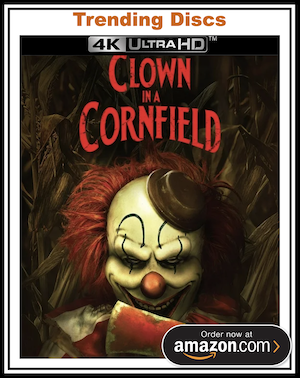Michael Scott
Partner / Reviewer
More
- Preamp, Processor or Receiver
- Yamaha TRS-7850 Atmos Receiver
- Other Amp
- Peavy IPR 3000 for subs
- Universal / Blu-ray / CD Player
- Panasonic UB820 4K UHD Player
- Front Speakers
- Cheap Thrills Mains
- Center Channel Speaker
- Cheap Thrills Center
- Surround Speakers
- Volt 10 Surrounds
- Surround Back Speakers
- Volt 10 Rear Surrounds
- Rear Height Speakers
- Volt 6 Overheads
- Subwoofers
- 2x Marty subs (full size with SI 18's)
- Video Display Device
- Sony 85 inch X950H FALD TV
Aaaand to finish off Shout! Studios blitz of Mamoru Hosoda’s 4K re-releases, we get to his best work yet. A movie that somehow managed to push past the boundaries of Otakus to actually hit the zeitgeist of American cinematic culture in 2006. For some reason, the dramatic, slice of life, sci-fi, romance films were able to pull on the heartstrings of American culture and get not one, but TWO returns to theaters due to the support. Originally released on Blu-ray by the now-defunct Bandai (goodness, I miss Bandai releases), the film has been rescued by Funimation (who is also now defunct) and finally Shout! Studios get their turn at it with a classy Amazon exclusive 4K Steelbook release (and a Blu-ray, but the 4K is Steelbook only).
Easily Mamoru’s best work, The Girl Who Leapt Through Time is taken from a 1967 novel of the same name by Yasutaka Tsutsui, telling the story of a young girl named Makoto who suddenly finds herself with the ability to jump through time. Makota is your typical high school girl with typical high school problems. Loads of homework, a crush who doesn’t return her affections, and accidentally crashing head-on into a train. However, instead of killing her, the train crash activates a latent power to leap backwards through time and wakes her up a few minutes before the crash. Instantly diving on this opportunity, Makoto leaps back through time over and over again, using her newfound ability to bend reality to her will. Now she can pass her exams with a few quick leaps, hang out with friends for 10-hour stints, and generally just serve herself.
Of course, little things that are inconsequential sprout into bigger problems, especially when she realizes that her time jumping and altering events may benefit her, but actually harm other people unintentionally. To make matters worse, her friend Chiaka has been trying to tell her that he’s got a crush on her, and Makota dodges the awkward situations by jumping back in time and heading the conversation in a different direction before he can bring it up again. And just as all gifts are given, they are taken away, as Makota learns almost too late that her ability to jump has a finite number to it, and she has to figure out what to do with her last remaining jump.
HOWEVER, there is one semi-major “problem” with the film that frustrates me, and keeps this from being a full 5-star film. The ending. In typical Japanese fashion, the ending is one of those open-ended ended bittersweet endings that gives you just enough hope to put a smile on your face, but so much open-endedness that you have to make up a final scenario that fits your particular view. A lot of people absolutely loved the open-endedness of the film as it allowed them to fill in their own happy ending, but as a concrete random personality type, the open-ended final moments drove me nuts. I get some of the twists that Hosoda was going for, and the various interpretations that fans have come up with over the years are incredible, but I really, REALLY wanted that happy ending that we were all going for. But, I fully admit that it is a personal thing, as this is a beloved anime film for a big reason. It just works, even with the bittersweet ending.
The film itself is less of an adaptation and more of a loose sequel to the 1960s novel that I mentioned above, as there are HEAVY implications that Makota’s “witchy” aunt is actually the protagonist from the novel. Even goes so far as to include the time traveler from that story in one of her aunt’s stories. The story manages to blend elements of Run Lola, Run…. Groundhog Day, and Japanese romances all in one weird blending, yet still manage to be a unique telling of the original novel (which has spanned multiple generations, a TV miniseries, a 2-book Manga, and several other serialized publications over the years). All in all, this is a sweet and charming story that has been told and retold over and over again for good reason.
Rating:
Not Rated by the MPAA
4K Video:
 Video:
Video: Audio:

Extras:

• Feature Commentary with Director and Voice Cast
• Storyboard Commentary
• Teasers & Trailers
Final Score: 

Mamoru Hosoda is one of my favorite directors, and The Girl Who Leapt Through Time is probably his best work, followed by Belle. He has a unique texture to all his movies, and he manages to switch genres like most people switch hats. The Girl Who Leapt Through Time happens to be his most accessible and popular film to date, and Shout! Studios has given this a solid upgrade over the older Funimation Blu-ray (sadly, I never got the Bandai disc to compare), and the steelbook packaging is just icing on the cake. This comes as no surprise that I’m giving this a “good buy” rating.
Technical Specifications:
Starring: Riisa Naka, Takuya Ishida, Mitsutaka Itakura, Mitsuki Tanimura
Directed by: Mamoru Hosada
Written by: Yasutaka Tsutsui, Satoko Okudera
Aspect Ratio: 1.78:1 HEVC
Audio: English: DTS-HD MA 5.1, Japanese DTS-HD MA 5.1
Subtitles: English SDH, English, Spanish, French
Studio: Shout! Studios
Rated: NR
Runtime: 98 Minutes
Blu-ray Release Date: October 7th, 2025
Recommendation: Great Buy















